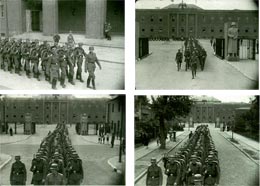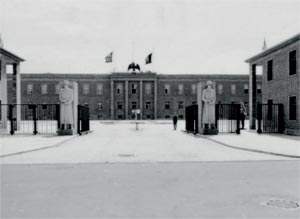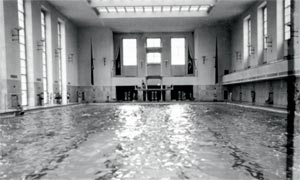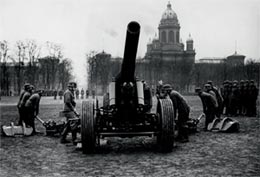
In April of 1933 the SS-Sonderkommando Berlin (Special Forces), which arose from the Stabswache Berlin (Staff Guards) and the Landespolitzeigruppe Weke (State Police group) moved into the buildings. The Landespolizeigruppe, which later changed its name to Landespolizeigruppe Herman Goering,and the SA-Stabwache, which moved there in the fall of 1933, occupied both western barracks until their relocation in December 1934.

A unit marches past the indoor swimming pool from the grounds of the "Adolf-Hitler Barracks", along Stern Strasse, today's Kadettenweg. The photos are from a 1940 newsreel.
The SS-Sonderkommando Berlin moved into the eastern barracks and were renamed the Leibstandarte SS Adolf Hitler (Elite Regiment) after the "Fuehrer" took his oath of office on 9 November 1933.
By 1934 the Leibstandarte had already grown to 986 men and crowded out the others using the barracks. In 1935 the number of soldiers increased to 2,918 and reached the strength of a motorized-infantry regiment. Space in the barracks became limited. The covered walkways connecting the buildings were removed because they hindered the vehicles' freedom of movement. In 1937 the property was extended to the south to make room for workshops, sports facilities, sheds and artillery storage. With these changes, the grounds were now re-oriented to Finckensteinalle, where the new main entrance was located
From 1937 to 1938, according to the plans of the architects Reichle, Weygandt and Badberger, the entrance gates, the facilities building, the storage hall and the indoor swimming pool, which was the largest building, came into being.
The indoor swimming pool building, with a pool measuring 25 by 50 meters for the Leibstandarte, was one of the largest indoor swimming pool structures of its time. At the head of the indoor pool building there were flat annexes with space for the changing rooms. Both entrances were framed with, as they still are today, larger-than-life-sized granite figures of men and women. Light shone through a glass ceiling that was as big as the pool beneath it in the 15-meter high, steel and concrete structure. The interior of the indoor swimming pool was characterized by large vertical windows which could be lowered into the floor, thereby allowing the outside space to be used as an area to lie and relax.
Two symmetrical tower houses replaced the old gatekeeper's house and were used as a guard post and jail cell as well as a post room and training facility. The entrance portal was flanked by two monumental granite posts in front of which "Reichsrottenfuehrer"- statues of SS men - were posed.

A view from the new Finckensteinallee entrance towards the newly built facilities building's annex with its central projection, inscription and Reichs eagle. Two symmetrical tower houses replaced the old gatekeeper's house. Two monumental figures guarded the entrance, the so-called "Reichsrottenführer".

After building for two years, the indoor swimming pool was finished. Measuring 60 x 31 x 15 meters, it was the largest of its time. Wide and massive with simple straight lines, it reflected the basic building style of the Third Reich.

Both entrances to the indoor swimming pool are still flanked today with two, four-meter high granite figures that symbolize the "German man" and the "German woman". These were designed by Professor Hass.

The 25 x 50 meter heated indoor swimming pool for the Leibstandarte with a 10-meter high diving tower. Sunlight streamed through the 15-meter high glass ceiling. The interior was characterized by the huge vertical windows which could be lowered into the floor.
The former laundry room had been torn down in order to create a representaional entrance area that was wide open for use as a troop formation area. An addition was built onto the main portal, across from the facilities building, giving it essentially its current appearance. The focal point of this classically graceful facade was a central projection with limestone pilasters, and at that time bore the inscription: "Leibstandarte SS Adolf Hitler" with the Reichs eagle and swastika. All of the buildings were built with red brick facades so as to match the appearance of the existing buildings.
In 1943 the buildings received their first war damage. Aerial photographs from February 1944 show that the classroom building was partially destroyed by bombs. In April 1945 the headquarters and the southwest barracks were burned down. After the main portion of the SS-Leibstandarte was ordered to the front at the outbreak of the war, a mere three battalions remained on the grounds: the training and replacement battalions as well as the guard battalion. They fled the barracks on 22 April with the advancement of the Red Army.
